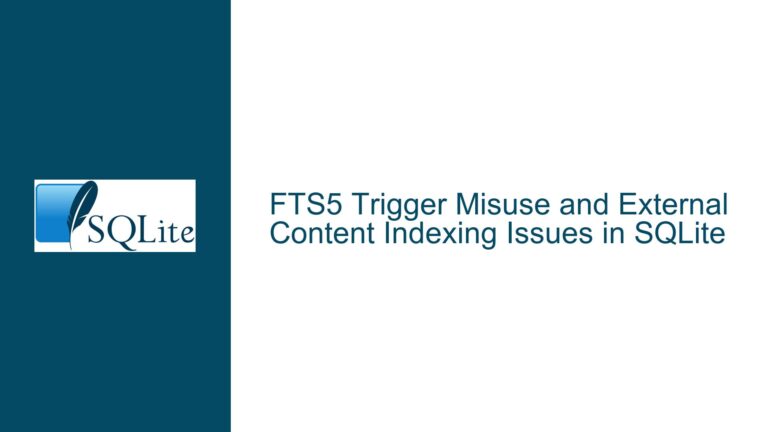Optimizing SQLite for Incremental and Continuous Session Data Updates
Balancing Single-Row vs. Multi-Row Data Storage for Session State Management
When designing a database schema for storing session data in SQLite, one of the most critical decisions revolves around how to structure the data storage: should the data be stored in a single variable-size row or split across multiple nearly fixed-size rows? This decision impacts not only the performance of frequent writes but also the complexity of managing the data, especially when dealing with hierarchical structures like nested notebooks and tabs. The core issue here is determining the optimal balance between these two approaches to ensure efficient writes and manageable data retrieval.
The primary concern is the trade-off between writing larger amounts of data to a single row versus writing smaller amounts of data across multiple rows. While the former simplifies data management by reducing the number of rows, it can lead to increased write times if the data size grows significantly. On the other hand, splitting data across multiple rows can reduce the size of individual writes but may increase the complexity of managing relationships between rows, such as maintaining tab order or handling nested structures.
Understanding the Impact of Write Operations on SQLite Performance
The performance of write operations in SQLite is influenced by several factors, including the size of the data being written, the number of pages affected, and the overhead associated with committing transactions. SQLite operates on a page-based storage system, where data is written in units of pages. Writing a single byte or a full page incurs a similar cost in terms of I/O operations, as the entire page must be written to disk. Therefore, the cost of writing a large amount of data to a single row is not significantly different from writing smaller amounts of data to multiple rows, as long as the total number of pages affected remains the same.
However, committing a write transaction is often the most expensive part of the operation. Each commit involves ensuring data durability, acquiring an exclusive lock, and writing to the write-ahead log (WAL). These operations introduce overhead that can dominate the total write time, especially in scenarios with frequent small writes. Therefore, minimizing the number of transactions by batching writes can improve performance. This is particularly relevant when dealing with session data, where frequent updates are expected.
Another consideration is the impact of indexing and triggers on write performance. If the schema includes indexes or triggers that update multiple rows, the cost of writing to multiple rows can increase significantly. For example, maintaining a map of tab positions within a notebook may require updating multiple rows whenever a tab is reordered. This can lead to additional overhead, especially if the updates are not batched efficiently.
Strategies for Efficient Session Data Storage and Retrieval in SQLite
To optimize the storage and retrieval of session data in SQLite, several strategies can be employed. First, consider the nature of the data being stored. If the data is hierarchical, such as nested notebooks and tabs, it may be beneficial to store the data in a normalized form, with each component stored in a separate row. This approach simplifies data management and allows for more granular updates, reducing the amount of data written in each transaction.
However, if the data is relatively small and does not grow significantly over time, storing it in a single row may be more efficient. This approach reduces the complexity of managing relationships between rows and can improve write performance by minimizing the number of transactions. Additionally, using a JSON or similar format to store hierarchical data in a single row can provide a balance between simplicity and flexibility.
Another strategy is to use triggers to automate the maintenance of relationships between rows. For example, a trigger can be used to update the positions of tabs within a notebook whenever a tab is reordered. This approach can reduce the complexity of the application code but may introduce additional overhead during write operations. Therefore, it is essential to carefully design triggers to minimize their impact on performance.
Finally, consider the use of batching to reduce the number of transactions. By grouping multiple writes into a single transaction, the overhead associated with committing each write can be minimized. This is particularly effective when dealing with frequent small writes, such as those generated by session data updates. Additionally, using the WAL mode in SQLite can improve write performance by allowing concurrent reads and writes, reducing contention for locks.
In conclusion, the decision to store session data in a single row or multiple rows in SQLite depends on the specific requirements of the application, including the size and structure of the data, the frequency of updates, and the need for efficient data retrieval. By carefully considering these factors and employing strategies such as normalization, triggers, and batching, it is possible to design a schema that balances performance and complexity, ensuring efficient and reliable session data management.






